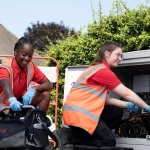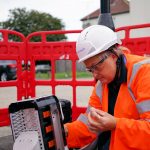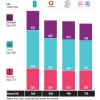Vodafone Cough to Using Some of Three UK’s Mobile Spectrum
Mobile operator Vodafone has called it a “genuine mistake” after one of their cell sites at London’s Gatwick airport was spotted using Three UK’s slice of the 4G friendly 1800MHz radio spectrum band. The latter is now checking to see whether any other such mistakes have been made.
The spectrum frequency in question concerns the 5.8MHz downlink slice owned by Vodafone (1810.9 – 1816.7MHz) and the neighbouring 10MHz chunk owned by Three UK and formerly EE (1816.7 – 1826.7MHz), which includes a small sliver of frequency inbetween to act as a guard-band against interference (see Ofcom’s spectrum map).
Spectrum like this is highly valuable and operators pay a lot of money for it, which is why even a few wayward MHz can be such a concern. In this case it was discovered that Vodafone had harnessed a 10MHz block starting from 1813.8MHz, which meant they ended up slipping over the guard-band and into some of Three UK’s frequency, thus sapping performance and capacity from a rival.
Advertisement
A spokesperson for Vodafone told The Register that the problem had been caused by a subcontractor who had “inadvertently configured the site to work on the 10MHz bandwidth rather than the correct one,” which they say has now been corrected. “It was a genuine mistake and we are looking into it as a matter of urgency,” continued the spokesperson.
Ofcom said they were aware of the issue and had encouraged the two operators to resolve any remaining problems. Meanwhile Three UK confirmed the “error” and noted that “a number of our customers would have seen a drop in performance for a short period of time in this area. Other sites may have been affected and we are working with Vodafone to investigate this.”
In addition Three UK has humorously offered Vodafone some extra “support and training on mobile mast configuration.”
Mark is a professional technology writer, IT consultant and computer engineer from Dorset (England), he also founded ISPreview in 1999 and enjoys analysing the latest telecoms and broadband developments. Find me on X (Twitter), Mastodon, Facebook, BlueSky, Threads.net and Linkedin.
« Business ISP Fibregig Partners ITS to Boost London Full Fibre


















































Comments are closed